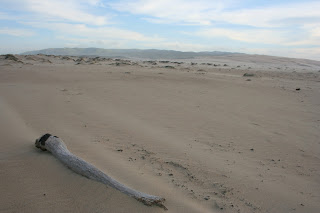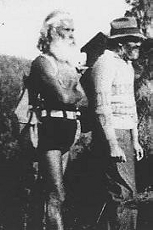In the 1950s, James Dean was fast becoming a well-known movie star. He loved making movies, and he also loved fast cars, specifically a silver Porsche Spyder 550 he named “Little Bastard.” In the early afternoon of September 30, 1955, Dean and Porsche factory mechanic Rolf Weutherich were on their way to an auto rally in
Salinas, California. Dean was pulled over for speeding in
Bakersfield, issued a citation for driving 65 in a 55 zone and released. Dean and his companion continued on their way towards Paso Robles with plans to spend the night, and then head to
Salinas the next morning.
 |
| Dean and "Little Bastard." |
As Little Bastard climbed down toward the little town of
Cholame around dusk, Donald Turnupseed, a 23-year old Cal Poly student was heading the opposite direction in his 1950 Ford Tutor. He began a left turn at the intersection of Highway 41 and what was then called State Route 466 (later named Route 46), unaware of the Spyder approaching. The two vehicles met nearly head-on. Little Bastard crumpled and spun around, throwing Weutherich out of the vehicle. The car came to rest about 15 feet off the road near a telephone pole. Weutherich suffered a broken leg and serious head injuries, though he survived. Turnupseed escaped with a bruised nose and gashed forehead. However Dean suffered fatal injuries. The Coroner listed the cause of Dean’s death as a broken neck, multiple fractures of the upper and lower jaw, fractures to the left and right arms and severe internal injuries.

Contrary to news reports of the day, Dean’s car was not going in excess of 80 MPH. California Highway Patrol Officer Ron Nelson, one of the first to arrive on the scene, wrote in his report that the wreckage and position of Dean’s body, “indicated his speed at the time of the accident was more like 55 MPH.” Nevertheless, people speculated Dean was speeding and that he was still alive shortly after the accident. Regardless, he was pronounced dead at a Paso Robles hospital. He was 24.
 |
| CHP officers Ron Nelson (L) and Ron Tripke (R) |
In 1977, a James Dean memorial was erected near the site of the crash. The stylized sculpture is composed of concrete and stainless steel around a tree located next to the Jack Ranch Café in Cholame. The café is still there as is the memorial, but that’s all that’s left of the little town. Japanese artist Seita Ohnishi built the memorial in
Japan and transported it to the
U.S., never clearly revealing why he had done this. At the dedication Ohnishi stated, “I am only one of many who feel strongly that James Dean should not be forgotten. There are some things, like the hatred that accompanies war, that are best forgotten. There are others, like the love inspired by this young actor that should be preserved for all time.”
The memorial is not the exact spot where the crash occurred; that spot is approximately 900 feet to the northeast, before the highways were realigned. In September 2005 the intersections of highways 41 and 46 were renamed the James Dean Memorial Highway. Donald Turnupseed went on with his life, forming a fairly successful electrical contracting business and avoiding the spotlight. He refused all interviews and passed away in 1995, never talking about the crash. The site still draws visitors and curiosity seekers. James Dean made only three films:
Rebel Without a Cause, East of Eden, and
Giant, but his legacy lives on.








